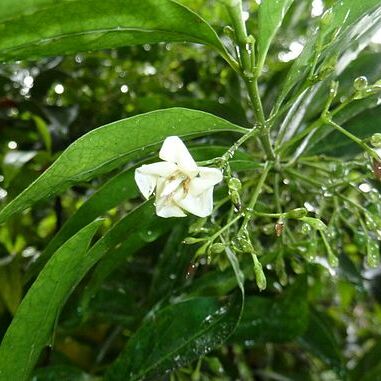Style short, fleshy, swollen and usually spindle-shaped, glabrous; pollen presenter long, exserted, fusiform, divided into 2 arms but these are usually held together save at the tip when mature, pubescent, with or less often without 10 membranous ciliate wings (not in the Flora area).
Leaves opposite, petiolate; blades usually drying grey to mahogany-brown, obtuse to acuminate, papery to subcoriaceous; domatia often present; stipules triangular to lanceolate, ridged, sometimes apiculate.
Corolla tube very shortly cylindrical at the base, funnel-shaped or campanulate above, densely bearded at the throat; lobes usually exceeding the tube in length, oblong-lanceolate or narrowly obovate.
Flowers hermaphrodite, (4)5-merous, in axillary pedunculate inflorescences, usually laxly arranged with well developed pedicels (or rarely pedicels absent); bracts and bracteoles present.
Stamens attached at the mouth of the tube, exserted and spreading; filaments short; anthers dorsifixed near the base, linear, with connective distinctly apiculate.
Seeds 2–6 per fruit, ± ovoid or hemispherical, usually with one flattened face, finely reticulate; hilar cavity or groove not present; endosperm entire.
Calyx glabrous to puberulous; tube ovoid to turbinate; limb-tube very reduced (or rarely not); lobes well developed, sometimes pubescent within.
Ovary 2-locular; placentas attached near the top of the septum, large or moderately small with 1–3 impressed ovules.
Fruit globose, somewhat fleshy, containing numerous red granules; calyx limb persistent.
Shrubs; branches glabrous or less often pubescent.
Disk annular.

